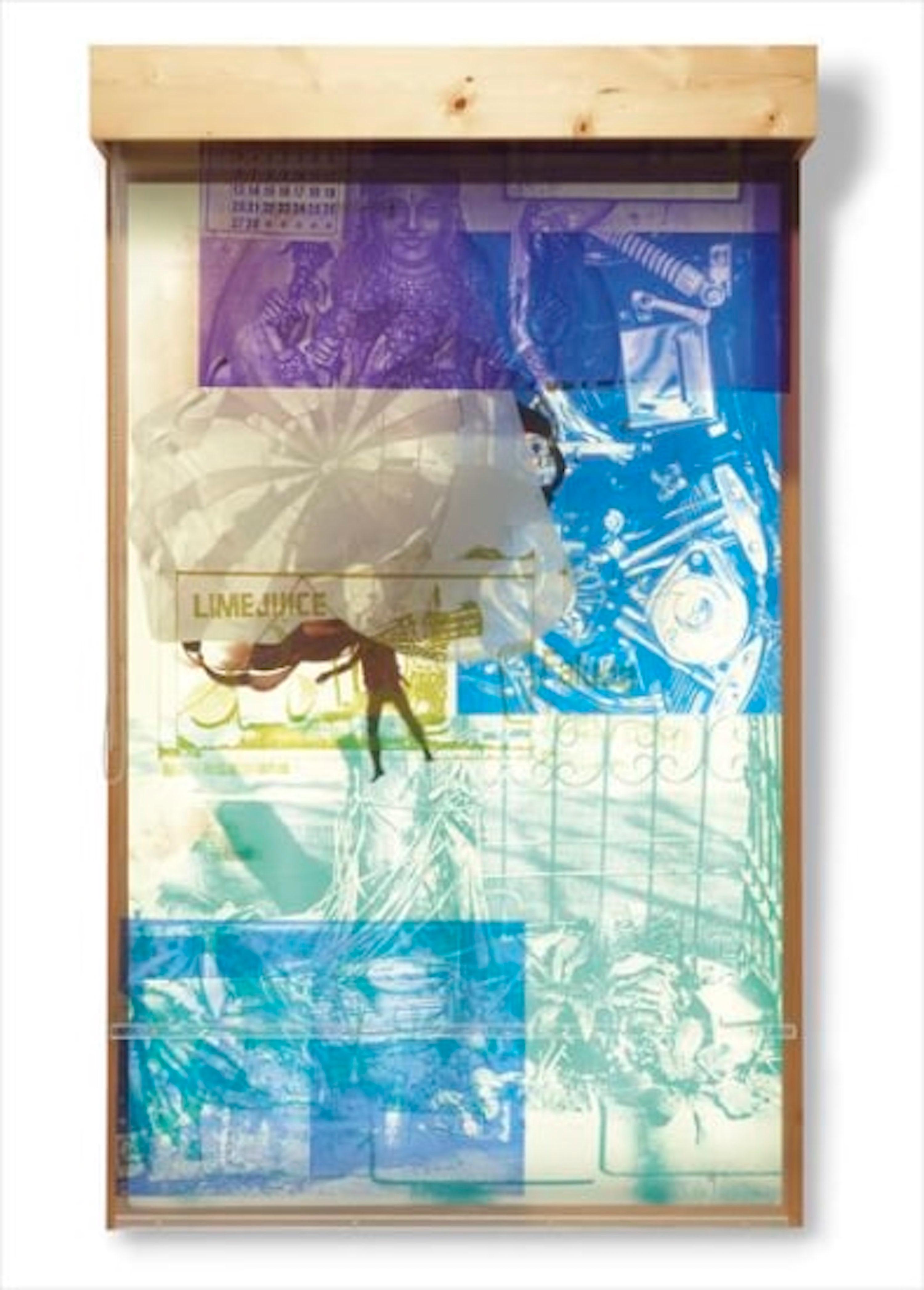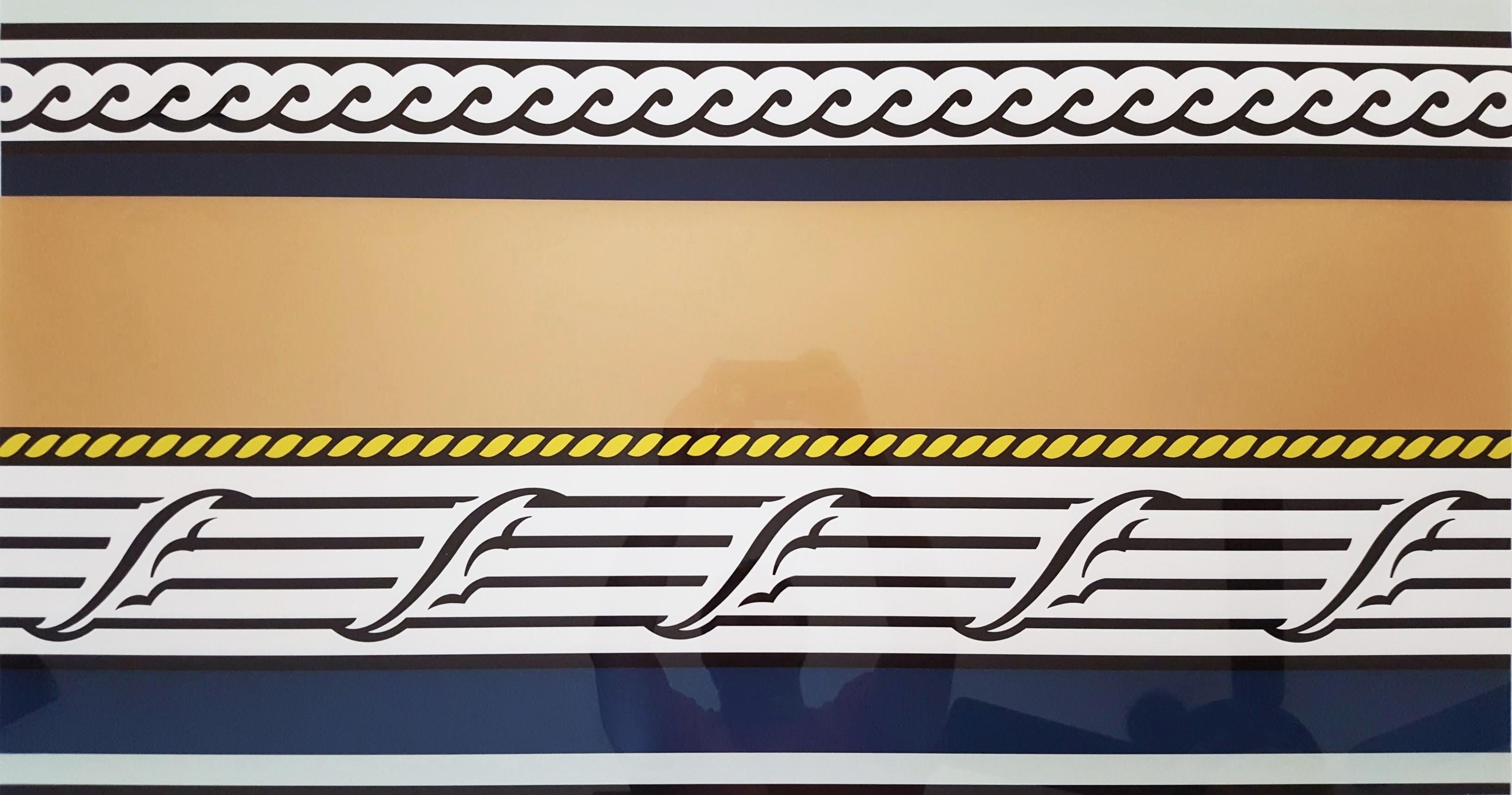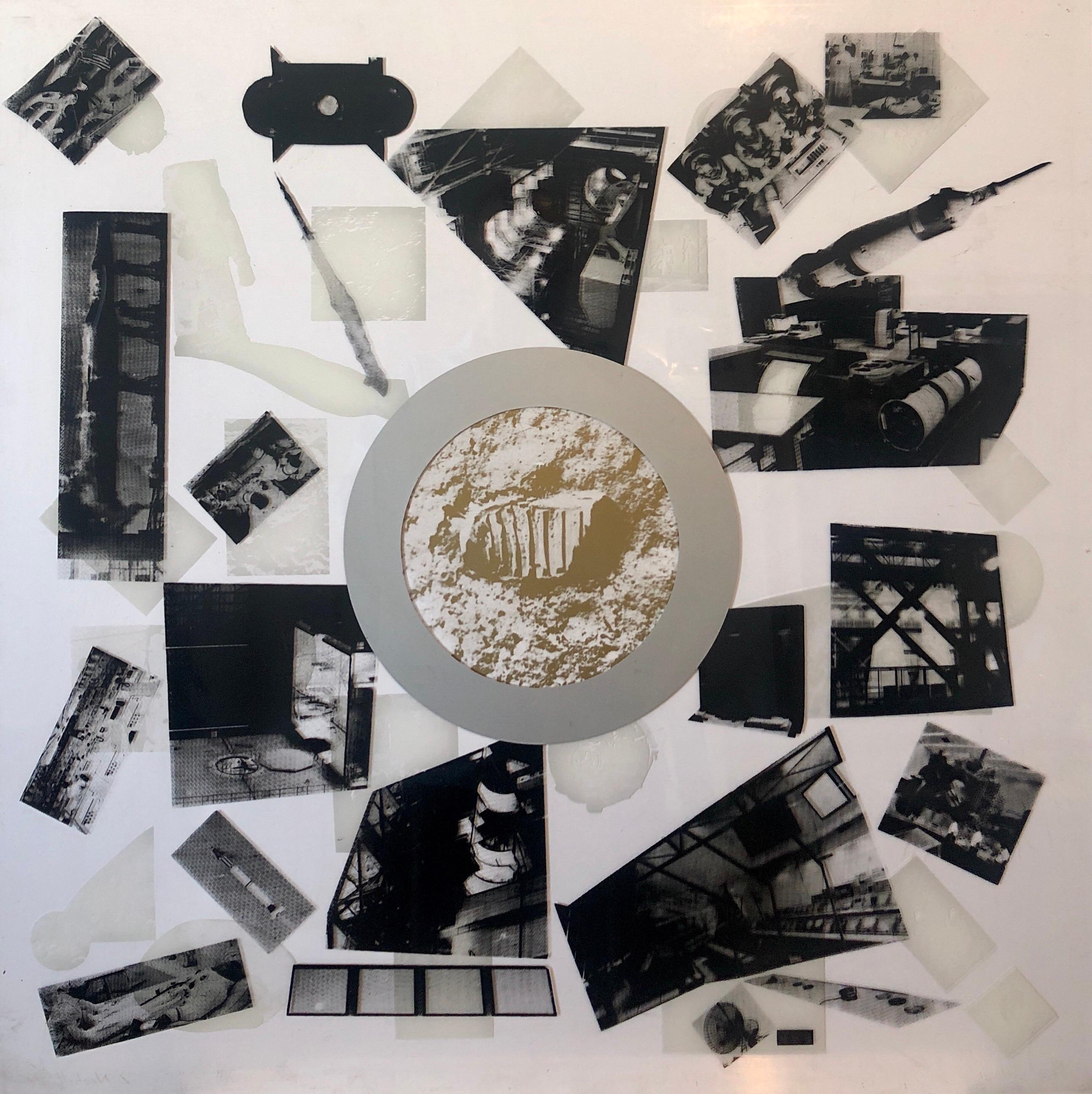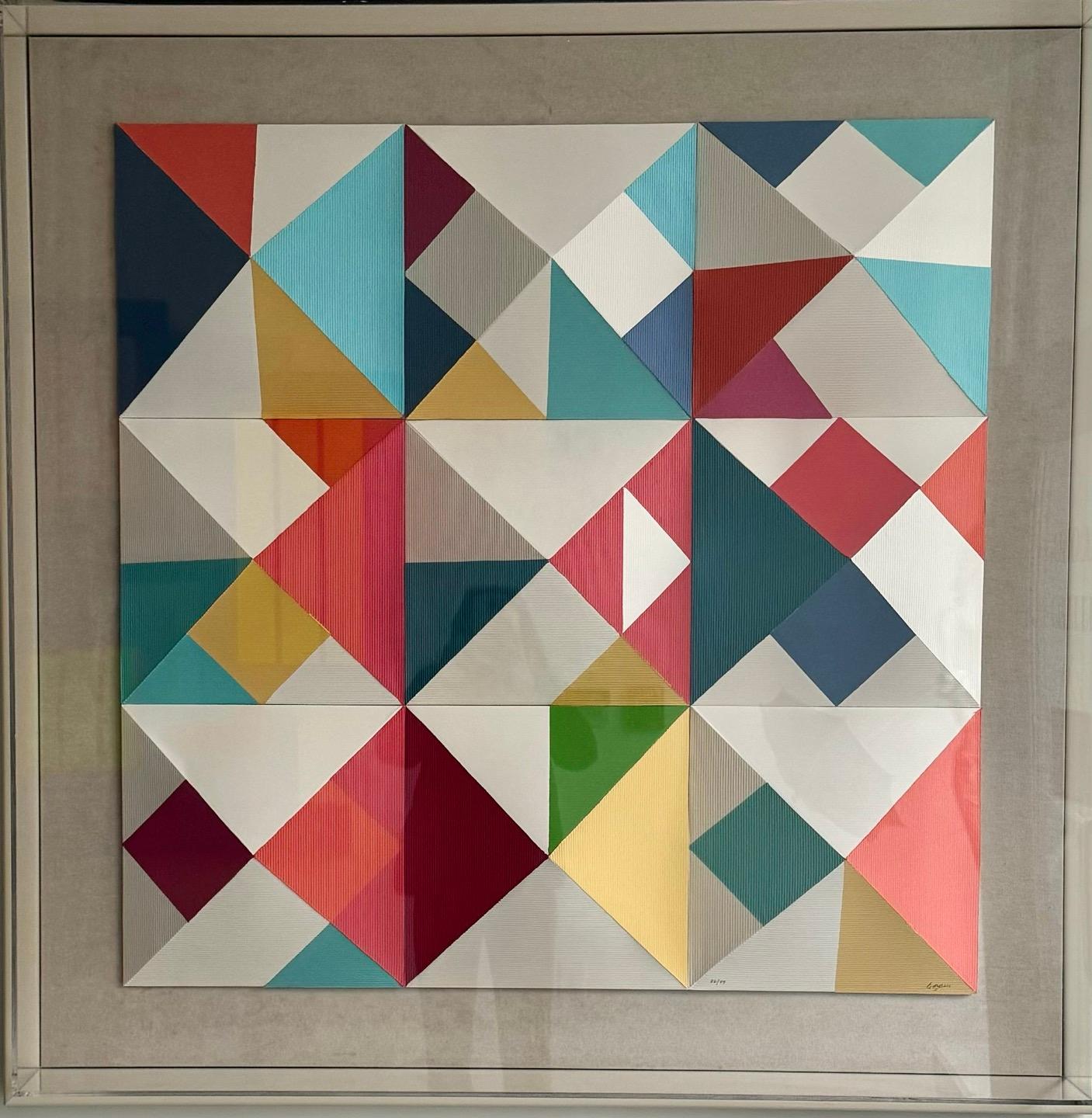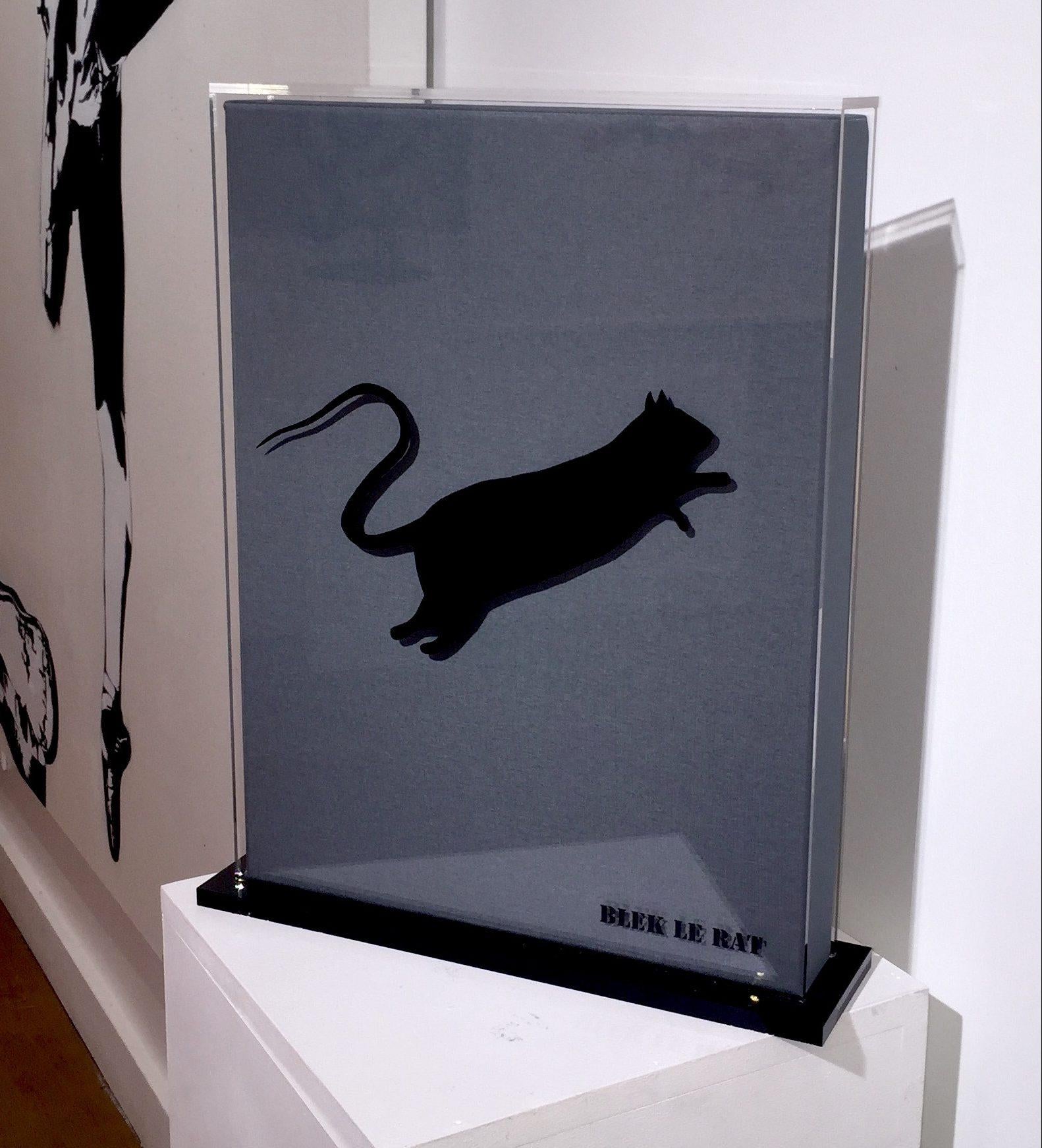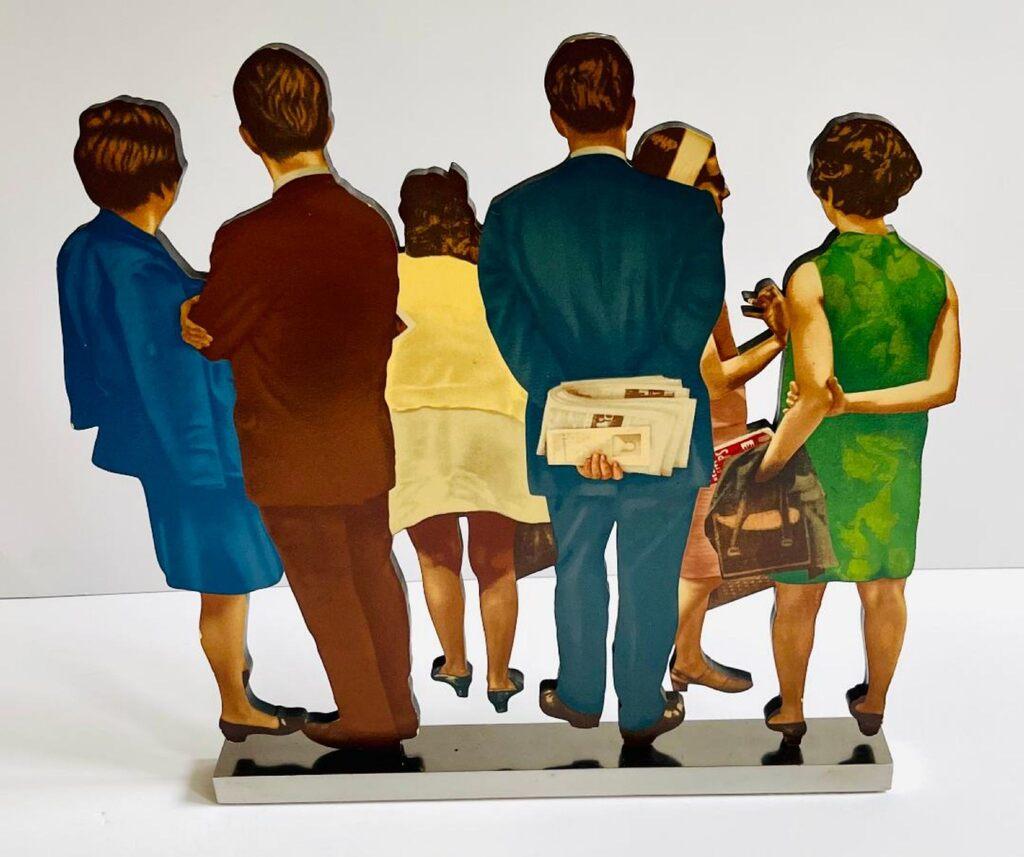Jesús Rafael SotoScreenprints A, B, C, D from the "Jai-Alai Series"1969
1969
About the Item
- Creator:Jesús Rafael Soto (1923 - 2005)
- Creation Year:1969
- Dimensions:Height: 24.75 in (62.87 cm)Width: 19.38 in (49.23 cm)
- Medium:
- Period:
- Condition:
- Gallery Location:New York, NY
- Reference Number:1stDibs: LU29327357062
Jesús Rafael Soto
Venezuelan Op and kinetic painter and sculptor Jesús Rafael Soto (1923–2007) is perhaps best known for his immersive installations, which respond to their environments and physically absorb the viewer in a dynamic sensory experience.
The exploration of space is central to Soto’s work. This is evident in his early paintings, of the 1950s, which create the illusion of movement through simple compositions and a limited palette. During the same period, he integrated industrial materials like nylon and steel into linear constructions that were part painting, part sculpture.
But Rafael Soto’s grandest and most enigmatic creations are his “Pénétrables.” Made up of thousands of long clear or colored plastic strands suspended from the ceiling or from free-standing steel or PVC frames, these geometric sculptures play with the perception of space, inviting viewers to act as participants by moving within and through them.
The strips of some of the installations were partly painted, forming shapes when seen from a distance. The Houston Penetrable (2014), at the Museum of Fine Arts, Houston, for instance, appears to hold a floating yellow ellipse.
Rafael Soto created 25 “Pénétrables” over the course of his career. Each further blurred the line between reality and illusion and established viewers as not just spectators but as integral parts of the artwork itself.
Shop Jesús Rafael Soto's art now at 1stDibs.
- ShippingRetrieving quote...Ships From: New York, NY
- Return PolicyThis item cannot be returned.
- Jai-Alai Suite: Screen Print ABy Jesús Rafael SotoLocated in New York, NYJai-Alai Suite: Screen Print A, 1969 screenprint on plexi, edition of 300 24 1/4 x 19 3/5 in.Category
1960s Abstract Geometric Abstract Prints
MaterialsPlexiglass, Screen
- Jai-Alai Suite: Screen Print DBy Jesús Rafael SotoLocated in New York, NYJesús Rafael Soto Jai-Alai Suite: Screen Print D, 1969 screenprint on plexi, edition of 300 19 1/2 x 24 1/4 in.Category
1960s Abstract Geometric Abstract Prints
MaterialsPlexiglass, Screen
- Jai-Alai Suite: Screen Print BBy Jesús Rafael SotoLocated in New York, NYJesús Rafael Soto Jai-Alai Suite: Screen Print B, 1969 screenprint on plexi, edition of 300 24 1/4 x 19 3/5 in.Category
1960s Abstract Geometric Abstract Prints
MaterialsPlexiglass, Screen
- Jai-Alai Suite: Screen Print CBy Jesús Rafael SotoLocated in New York, NYJesús Rafael Soto Jai-Alai Suite: Screen Print C, 1969 screenprint on plexi, edition of 300 24 1/4 x 19 3/5 in.Category
1960s Abstract Geometric Abstract Prints
MaterialsPlexiglass, Screen
- Tree of Life fantasyBy Alice AycockLocated in New York, NYAlice AYCOCK Tree of Life fantasy, 1991 Edition 25 of 45 Silkscreen print (Acquerelio 400 gm grey) 39 1/4 x 27 1/2 in.Category
1990s Abstract Geometric Prints and Multiples
MaterialsScreen
- The World Above/The World Below According to the Pattern of the Rose Apple TreeBy Alice AycockLocated in New York, NYAYCOCK, Alice The World Above/The World Below According to the Pattern of the Rose Apple Tree 21/45, 1990 Silksreen print (Acquerelio 400 gm grey) 39 1/4 x 27 1/2 inches (unframed)Category
1990s Abstract Geometric Landscape Prints
MaterialsScreen
- Sling-Shots Lit #3By Robert RauschenbergLocated in Washington Depot,, CTlithograph & screenprint on paper & assemblage with Sailcloth, Mylar, Wooden lightbox, fluorescent fixture, aluminum moveable window shade system and Plexiglas Ed. 23/25Category
1980s Abstract Expressionist Prints and Multiples
MaterialsMylar, Plexiglass, Wood, Paper, Sailcloth, Lights, Lithograph, Screen
- Entablature IV /// Pop Art Roy Lichtenstein Large Design Architecture PatternBy Roy LichtensteinLocated in Saint Augustine, FLArtist: Roy Lichtenstein (American, 1923-1997) Title: "Entablature IV" Portfolio: Entablature Series *Signed and dated by Lichtenstein in pencil lower right Year: 1976 Medium: Original Screenprint and Collaged mat pink Metallic Foil with Embossing on Rives BFK paper Limited edition: 14/30, (there were also 9 artist's proofs) Printer: Tyler Graphics Ltd., Bedford Village, NY Publisher: Tyler Graphics Ltd., Bedford Village, NY Reference: "The Prints of Roy Lichtenstein: A Catalogue Raisonné 1948-1997" - Corlett No. 141, page 144; PCN 7 (July-August 1976); "Tyler Graphics Catalogue Raisonné 1974-1985" - Tyler No. 337:RL5, page 210 Framing: Framed in a contemporary white moulding with plexiglass and matted with a custom hand-wrapped 8 ply linen mat Framed size: 39.5" x 55" Sheet size: 29.19" x 44.82" Image size: 20.19" x 38" Condition: Some light cosmetic wear to frame; presently no hanging wire. The artwork is in mint condition Very rare Notes: Provenance: private company collection - Miami, FL, acquired directly from the publisher Tyler Graphics Ltd., Bedford Village, NY in the 1970's. Numbered by Lichtenstein in pencil lower left. Comes from Lichtenstein's 1976 "Entablature Series" portfolio of 11 prints, (Corlett No. 138-148). Printed in six colors, in seven runs, from five screens, and one embossing plate. Collaboration: Kenneth Tyler (project supervision, plate/screen preparation, proofing, collage, and embossing); Kim Halliday (screen preparation and processing, proofing, and edition printing); Betty Fiske (proofing and edition printing). Swan Engraving processed the magnesium plate. Tyler Graphics Ltd. chop mark/blind stamp lower right. Workshop number inscribed in pencil lower left on verso: "RL75-197". Comes with its original Tyler Graphics "Entablature Series" booklet. Between 1971 and 1976 Lichtenstein produced two series of "Entablature" paintings, using photographs of architectural ornament he had taken in New York as the starting point for his compositions (see Cowart [1981]). The first "Entablature" paintings (1971-72) were black and white. The second group used color and were produced at roughly the same time the "Entablature" series of prints were in production at Tyler Graphics Ltd., 1974-76. The first discussions between Lichtenstein and Ken Tyler concerning the "Entablature" prints took place in May, 1974. As recorded in the Tyler catalogue raisonne, technical research for the project began in September 1974 and production was completed in April 1976. Lichtenstein produced one or more collages for each print in the series to serve as models for the plates and screens. Both the "Entablature" paintings and prints are intimately concerned with texture - the metallic paint and sand of the paintings, the foils and embossing/debossing techniques employed in the prints. The imagery itself - machined architectural ornament - takes technology as its subject. As Barbara Rose suggests, "That industrialism disrupted our notion of style as much as reproduction altered our conception of representation appears to be the subjects of Lichtenstein's "Entablatures". For each print in this series, the Tyler Graphics Ltd. catalogue raisonne gives exact method and press types, as well as the initials of the printers for each run. To complete certain phases of the project, Tyler employed the following companies: Drake Engineering, Danbury, CT (for machining of the metal die); Swan Engraving, Bridgeport, CT (for plate processing); Tallix Foundry, Beacon, NY (for bronze casting); and Tompkins Tooling, Gardena, CA (for machining of the metal die). The ten embossing plates for the series are now in the collection of the National Gallery, Canberra, Australia. Biography: American artist Roy Lichtenstein was born in New York City on October 27, 1923, and grew up on Manhattan's Upper West Side. In the 1960s, Lichtenstein became a leading figure of the new Pop Art movement. Inspired by advertisements and comic strips, Lichtenstein's bright, graphic works parodied American popular culture and the art world itself. He died in New York City on September 29, 1997. Lichtenstein was committed to his art until the end of his life, often spending at least 10 hours a day in his studio. His work was acquired by major museum collections around the world, and he received numerous honorary degrees and awards, including the National Medal of Arts in 1995. In 2013 the painting "Woman with Flowered Hat" set another record at $56.1 million as it was purchased by British jeweler Laurence Graff from American investor Ronald O. Perelman. This was topped in November of 2015 by the sale of "Nurse" for 95.4 million dollars at Christie's auction. Subsequently, that was topped with the private sale of his 1962 painting...Category
1970s Pop Art Abstract Prints
MaterialsMetal, Foil
- MOONWALK 1970 Color Silkscreen Screenprint Acrylic Plexiglass Mod Space ArtBy Lowell NesbittLocated in Surfside, FLSpace Race Silkscreen on Acrylic hand signed and dated 1970, MOON WALK, color screenprint on Plexiglas depicting the moon landing, from the numbered edition of 150, size 30 x 30” Lowell Blair Nesbitt is an American painter, draughtsman, printmaker, and sculptor. Although he worked in a variety of media and covered a wide range of subjects throughout his career, he is best known for his large, Photorealist botanical paintings. Born in Baltimore, Maryland in 1933, Nesbitt earned a degree from the Tyler School of Art at Temple University. Later, he also studied at London’s Royal Academy of Arts. Working in stained glass and etching and also producing abstract paintings in his early career, a 1962 encounter with artist Robert Indiana led him to steer his aesthetic toward realism. Though he held his first solo show at the Baltimore Museum of Art in 1958, it was his 1964 debut at the Corcoran Gallery of Art in Washington D.C. that would truly bring him to the attention of the art world. In this exhibit, his botanical series of paintings, drawings, and prints captivated the art world and public alike. The game-changing Corcoran Gallery show would send his career down the trajectory of sustained success. In 1976, Nesbitt moved from his New York City West 14th Street studio to a massive space located at 389 West 12th Street. The 12,500 square foot living and workspace supplied ample room for creating his enormous paintings...Category
1970s Pop Art Abstract Prints
MaterialsPlexiglass, Screen
- 'Color Nines', 3-D Screen Print on folded paper by Yaacov AgamBy Yaacov AgamLocated in Rye, NYThis wall sculpture by Yaacov Agam is a 3D screen print on folded construction paper mounted in a plexiglass enclosure. It is # 86 in a series of 99 printed in 1984. The color palett...Category
1980s Contemporary Abstract Prints
MaterialsPlexiglass, Paper, Screen
- Classik BoxBy Blek Le RatLocated in Dallas, TXClassikbox – 2016 by Blek the rat Art casing – Ed.100 Containing 3 serigraphs Ed.100 The man who walks through walls / Madonna and Child / Beggar Screen-p...Category
21st Century and Contemporary Street Art Portrait Prints
MaterialsPlexiglass, Screen
- The People, signed 3D photo realist mixed media sculpture of people viewing artBy Howard KanovitzLocated in New York, NYHoward Kanovitz The People, 1971 3-5 Mixed Media Silkscreen on Plexiglas and aluminum base Signed: Artist's Signature etched on the work and annotated A.P., Edition of 1 (an Artists Proof, aside from the regular edition of 75) 15 × 16 × 1 1/2 inches Signatured etched on the work and annotated A.P. , aside from the limited edition of 75. This excellent 1971 3-D photo realist work "The People" is a multiple based upon a larger work the artist did of people beholding a work of art. Here, we see them only from behind, because they are busy looking at art - a clever photorealist work - art about art - catching people in the process of looking at art. Howard Kanovitz Biography Howard Kanovitz was a leader of Photo Realism: a documenter of style and fashion, depicting members of the art scene at openings, or superimposing known critics and curators onto images of board room meetings. In his particular style, he explored the intersections of painting, photography, fiction, and fact. Kanovitz studied at the Rhode Island School of Design and The Art Studenst League in Woodstock where he worked with Yasuo Kyniyoshi before moving to New York an apprenticing with Franz Kline. As a member of New York’s downtown art scene, Kanovitz painted abstract paintings, which he exhibited at Tenth Street Galleries early in his career. Following his father’s death in 1963, Kanovitz went through family photos, an experience which prompted him to interrogate the relationship between images and perception. At this time, Kanovitz abandoned abstraction in favor of a figurative style and worked arduously in this new direction. These efforts culminated in a 1966 solo exhibition at the Jewish Museum, securing his place as a leader of Photo Realism among artists such as Larry Rivers, Alex Katz, and Chuck Close. His photo based, representational paintings exhibited at the Jewish Museum show were the first to be called “photo-realist” and shocked many in the art community prompting a symposium which was held at the New York Studio School for “downtown artists” to weigh in on this perennial “hot topic”, newly addressed by one of their own. Kanovitz first began using airbrush in 1967, giving his paintings a feeling of photographic perfection. Cut out figures created using this precisionist technique were placed in the viewers space, often in front of Kanovitz’s painted canvas depicting the luminaries of the art world of the time. This type of installation was the centerpiece in the first of several Waddell Gallery shows. Kanovitz has been the subject of many solo museum shows internationally and his work is collected by institutions such as the Whitney Museum of American Art, Metropolitan Museum of Art, Tate Britain, London, and Museum Moderner Kunst, Vienna. -Courtesy Eric Firestone...Category
1970s Photorealist Mixed Media
MaterialsPlastic, Plexiglass, Mixed Media, Etching, Screen
